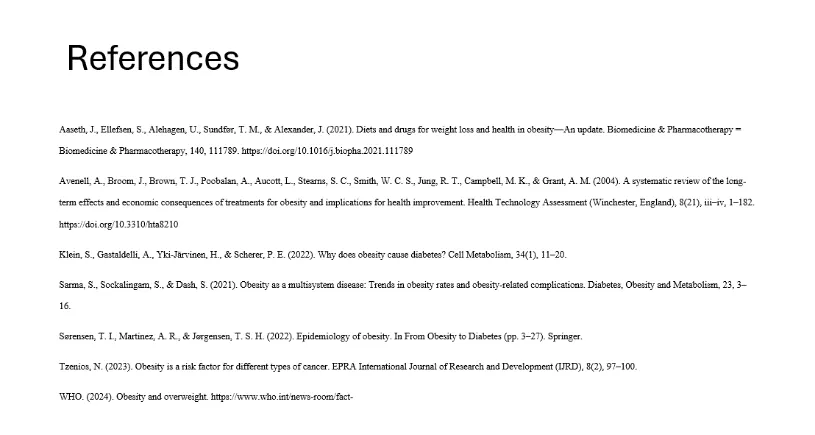HIM-FPX4610: Health Information Management Capstone - A Synthesis of Theory and Practice
Published: 2025-10-16
Modified: 2025-10-16
Samples Solutions
Introduction:
The HIM-FPX4610 – Health Information Management Capstone course helps students apply their knowledge of healthcare data systems, compliance, and leadership in real-world settings. It focuses on developing analytical and problem-solving skills essential for managing health information effectively. For expert guidance and academic support, explore our Nursing Coursework Help services to excel in your capstone project.
HIM-FPX 4610 Assessment One Skin Progress
Instructions for HIM-FPX 4610 Assessment One Skin Progress
Progress Note
Translate the medical terms contained in a progress note for a patient with a skin condition into common terms. Spell all medical and common terms correctly on the provided template.
Collapse All
Introduction
In this first assessment, you will begin your exploration of the structure of medical terminology. The first step is to review how to build a medical term. Then you will examine the skin and musculoskeletal systems; in particular, we will focus on the diagnosis and treatment of the integumentary, or skin system. The skin is the largest organ of the body, with a total area of about 20 square feet. The skin protects us from microbes and the elements, helps regulate body temperature, and permits the sensations of touch, heat, and cold. Your suggested resources address the three layers of skin, skin conditions, diseases, treatment, and diagnostic studies.
In the assessment, you will review a progress note. This is a common document found in a healthcare record in doctors’ offices and hospitals. You will then translate the medical terms in the progress note into common terms.
Demonstration of Proficiency
By completing this assessment, you will demonstrate your proficiency in the course competencies through the following assessment scoring guide criteria:
- Competency 2: Use medical terminology and abbreviations related to general structures and functions of the human body.
- Identify medical terms related to general structures and functions of the human body correctly.
- Translate medical terms related to general structures and functions of the human body into common terms correctly.
- Competency 3: Use medical terminology and abbreviations related to body systems.
- Identify medical terms related to body systems correctly.
- Translate medical terms related to body systems into common terms correctly.
- Competency 6: Spell and pronounce basic medical terms.
- Spell medical and common terms correctly.
- Competency 7: Communicate professionally.
- Provide citations and references in APA style.
Instructions
Review the progress note below, including the subjective and objective notations. Next, download the Skin Progress Note Template [DOCX] and complete all of the following on the template:
- Select 15 medical terms from the progress note.
- Translate the 15 selected medical terms into commonly used terms.
- Spell the 15 medical and common terms correctly.
- Cite in correct APA style the references you used to perform your translation. Click Evidence and APA for additional guidance on how to ensure your citations and references conform to APA guidelines.
Skin Progress Note
Subjective: The patient is a 49-year-old female who comes in with the complaint of having bumps on her arms. She states some of the bumps have been there a long time. Recently, the bumps have been increasing in number and size. She was last seen about two years ago for eczema, at which time she did not have these bumps. The bumps are not itchy or painful.
Objective: Very pleasant, alert, and oriented x3 female in no apparent distress. A full integumentary exam of the upper extremities was performed today. The left radial aspect demonstrated erythematous macules. The right ulnar aspect demonstrated actinic keratosis. Bilateral hands appeared dry with linear excoriation and fissuring of her fingertips. Bilateral upper arms demonstrated superficial and deep masses. Deep subcutaneous masses are mobile and may represent lipomas. Superficial masses appear to be sebaceous cysts.
Assessment and Plan:
- Actinic keratosis of the right ulnar aspect was treated with liquid nitrogen.
- Possible lipomas: Schedule surgical biopsy of larger masses.
- Sebaceous cysts: Punch biopsy performed today; await pathology report. Apply Neosporin to the biopsy site.
- Continue Cortisone 10 intensive cream for eczema.
Additional Requirements
- Format: Ensure you complete all columns on the Skin Progress Note Template.
- Scoring Guide: Be sure to read the scoring guide for this assessment, so you understand how your faculty member will evaluate your work.
Resources
Use the resources linked below to help complete this assessment.
Collapse All
Study Tips
- Speak it and use your new language! Examples:
- No longer say that you have a headache, but rather speak the medical term, cephalgia.
- If a child falls and scrapes a knee, let the child know the injury is a patellar abrasion.
- Use the textbook as a workbook.
- Use the interactive resource, Evolve Resources for The Language of Medicine, accompanying your textbook. Note: If you require the use of assistive technology or alternative communication methods to use this item, please contact Disability Services to request accommodations.
- Repetition, repetition, repetition!
- Start a portfolio—an alphabetized electronic or written portfolio of terms that you might have difficulty understanding or remembering.
- Write your notes in colored ink. Assign a special color to help improve your recall of terms; for example, use red ink for cardiology, green for gastrointestinal, blue or brown for ophthalmology, or whatever highlight makes sense to you. Researchers have found that colors help to improve memorization results.
- Relate ideas and terms.
- Levator muscles (hold up support tissue) = elevator (goes up).
- Use songs and games.
- E-mail your faculty member if you have questions or need clarification.
Medical Terminology Structure
These readings introduce the forms and word components that make up medical language, including suffixes and prefixes.
Chabner, D. (2017). The language of medicine (11th ed.). St. Louis, MO: Saunders. Available in the course room via the VitalSource Bookshelf link.
- Chapter 1, “Basic Word Structure,” pages 1–32.
- Chapter 3, “Suffixes,” pages 75–108.
- Chapter 4, “Prefixes,” pages 109–138.
Use the interactive activities in The Language of Medicine to study the skills and terms covered in this assessment. These activities include the practice applications and review activities located within each chapter. Completing these activities will help you prepare for this assessment.
In addition, you have access to flashcards and quizzes from the textbook’s companion website, Evolve Resources for The Language of Medicine, as well as practice quizzes for each chapter. Use these to further prepare yourself for your assessments.
Note: If you require the use of assistive technology or alternative communication methods to use these items, please contact Disability Services to request accommodations.
General Body Terms
Chabner, D. (2017). The language of medicine (11th ed.). St. Louis, MO: Saunders. Available in the course room via the VitalSource Bookshelf link.
- Chapter 2, “Terms About the Body as a Whole,” pages 33–74.
Musculoskeletal and Skin Systems
These readings cover the anatomy and physiology of the musculoskeletal and skin systems, along with word parts, vocabulary, and terminology needed to use these terms in health care settings.
Chabner, D. (2017). The language of medicine (11th ed.). St. Louis, MO: Saunders. Available in the course room via the VitalSource Bookshelf link.
- Chapter 15, “Musculoskeletal System,” pages 579–652.
- Chapter 16, “Skin,” pages 653–696.
Activity
Click Word Scramble: The Skin to complete an interactive activity that will enable you to practice using medical terminology relating to the largest organ of the body, which has a total area of about 20 square feet. This will help you prepare for the medical terminology relating to the skin that you will encounter in your assessment. Good luck.
This tool needs to be loaded in a new browser window
Introduction to HIM-FPX 4610 Assessment One
Hello to the Owlisdom How-To Guide of HIM-FPX 4610 Medical Terminology! This guide is designed to assist you in translating medical terms found in a patient’s progress note into commonly used language. Assessment One aims to enhance your understanding and use of medical terminology, ensuring you can accurately communicate medical information to a general audience. You will complete the task efficiently and effectively, following the steps outlined below.
Note: You will be provided with a template for Assessment One. I am using the assessment template by Capella University as an example for the sample solution.
Review the Progress Note
Before starting the HIM-FPX 4610 Assessment One Skin Progress, we will review the patient’s instructions and progress notes.
- Carefully read the progress note, focusing on subjective (patient-reported) and objective (clinician-observed) notations.
- Take note of any unfamiliar medical terms, as these may be candidates for translation.
Select 15 medical terms from the progress note.
Translate the 15 selected medical terms into commonly used terms.
Select 15 Medical Terms
Next, in HIM-FPX 4610 Assessment One Skin Progress. We will select 15 relevant medical terms for the patient’s skin condition. Then, we will provide a commonly used equivalent term for each selected medical term.
- Identify and list 15 medical terms from the progress note. These terms should be relevant and commonly used in the context of the patient’s skin condition.
- Ensure the selected terms cover a range of concepts, including symptoms, diagnoses, treatments, and anatomical references.
- Use reliable medical dictionaries or resources to ensure accurate translations.
- Keep translations clear and concise, avoiding medical jargon.
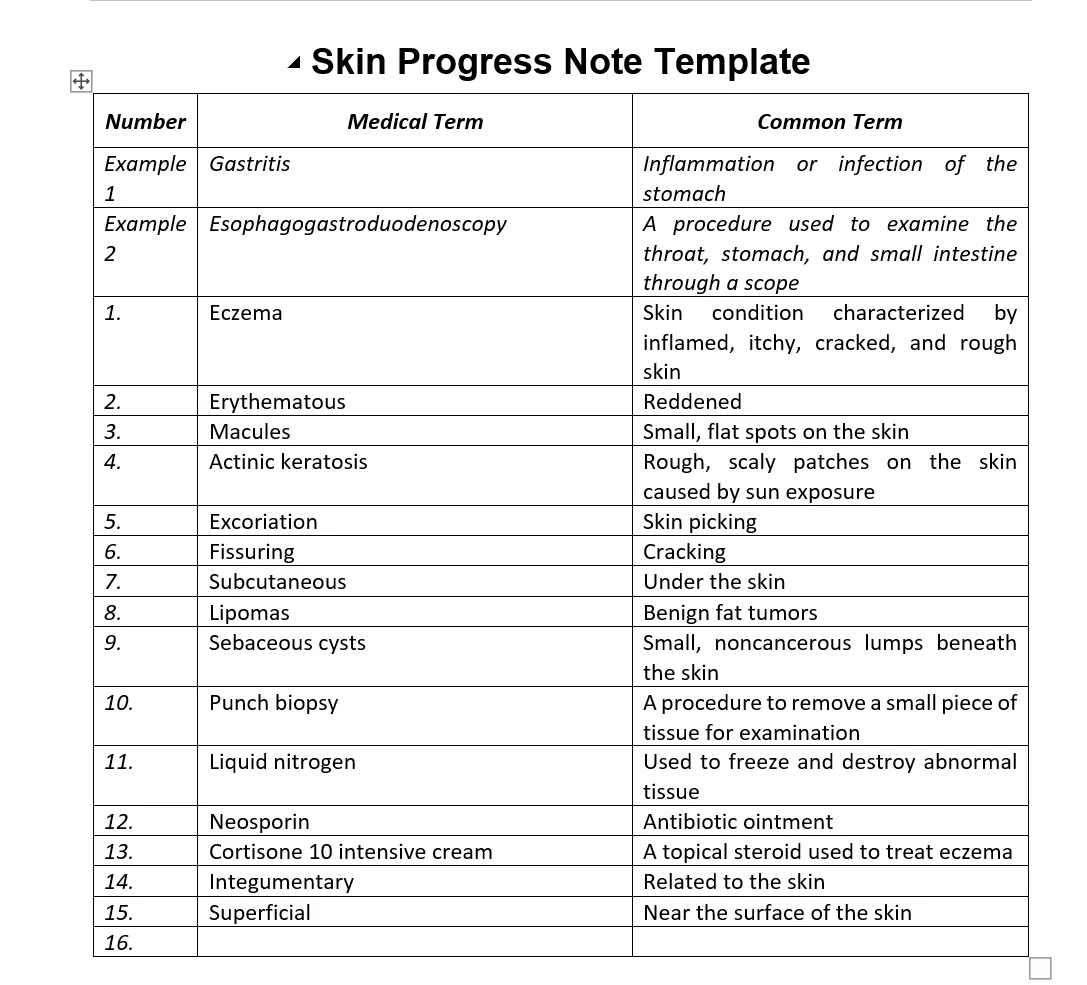
Spell the 15 medical and standard terms correctly.
Spell Check
In this section of HIM-FPX 4610 Assessment One Skin Progress. We will use the correct spellings for each selected medical term.
- Double-check the spelling of both the medical terms and their standard translations.
- Use spell-check tools or medical dictionaries to confirm accuracy.
Cite the references you used to perform your translation in the correct APA style. Click Evidence and APA for additional guidance on ensuring your citations and references conform to APA guidelines.
Citations and References
Finally, we will cite all our resources for the HIM-FPX 4610 Assessment One Skin Progress. We will be using APA style for references as required.
- Cite all sources used for translations in the correct APA style. This includes medical dictionaries, textbooks, and credible online resources.
- Refer to the “Evidence and APA” section for additional guidance on formatting citations and references according to APA guidelines.
Demonstration of Proficiency
By completing the HIM-FPX 4610 Assessment One Skin Progress, we will demonstrate our proficiency in several key competencies:
Competency 2: Use medical terminology and abbreviations related to general structures and functions of the human body. Identify and translate medical terms related to general structures and functions correctly.
Competency 3: Use medical terminology and abbreviations related to body systems. Identify and translate medical terms related to body systems correctly.
Competency 6: Spell and pronounce basic medical terms. Ensure all medical and standard terms are spelled correctly.
Competency 7: Communicate professionally. Provide proper citations and references in APA style.
Note: These competencies are not overly complicated. They are intended to give you a clear idea of approaching and solving the assessment. With careful attention to detail and the use of reliable resources, you will be able to complete the task successfully.
Closing
Completing the HIM-FPX 4610 Assessment One Skin Progress will improve your ability to translate medical terminology and enhance your overall communication skills in a medical context. The key takeaways include understanding the importance of accurate translation, ensuring proper spelling, and adhering to APA citation guidelines. This How-To Guide helps nourish the skills essential for effective communication in healthcare and will be valuable in your future career.
The following assessment will discover the medical terms or abbreviations of the standard terms found in a patient’s History and Physical (H&P). In the next module of HIM-FPX 4610, we will explore Assessment Two on Skin Progress.
HIM-FPX 4610 ASSESSMENT TWO Skin Progress
Instructions for HIM-FPX 4610 Assessment Two Skin Progress
History and Physical (H&P)
Translate into medical terms or abbreviations the common terms found in the history and physical (H&P) of a patient who presented to an emergency room with a number of issues. Spell all medical terms or abbreviations and common terms correctly on the provided template.
Collapse All
Introduction
This second assessment continues to explore medical terminology related to various body systems, general structures, and functions of the human body, including the digestive and nervous systems, as well as psychiatry terminology. Our focus in this assessment will be on the nervous system. The nervous system is a complex network of nerves and cells that carries messages to and from the brain and spinal cord to various parts of the body. The nervous system includes the central and peripheral nervous systems. Your suggested resources address how the nervous system functions and what jobs it performs. They also focus on diseases, treatments, and diagnostic studies related to the nervous system.
In the assessment, you will review a patient’s history and physical (H&P), another common document found in acute care settings. You will translate the common terms in the H&P into the correct medical terms or abbreviations.
Demonstration of Proficiency
By completing this assessment, you will demonstrate your proficiency in the course competencies through the following assessment scoring guide criteria:
- Competency 2: Use medical terminology and abbreviations related to general structures and functions of the human body.
- Identify common terms related to the general structures and functions of the human body correctly.
- Translate common terms related to general structures and functions of the human body into medical terms or abbreviations correctly.
- Competency 3: Use medical terminology and abbreviations related to body systems.
- Identify common terms related to body systems correctly.
- Translate common terms related to body systems into medical terms or abbreviations correctly.
- Competency 6: Spell and pronounce basic medical terms.
- Spell common and medical terms or abbreviations correctly.
- Competency 7: Communicate professionally.
- Provide citations and references in APA style.
Instructions
Review the H&P below for a patient who presented in the emergency room with a number of issues. Pay close attention to the present and past history, medications, allergies, social and family history, review of systems, physician exam, and assessment and plan. Next, download the Patient History and Physical Template [DOCX] and complete all of the following on the template:
- Select 15 common terms from the H&P.
- Translate the 15 selected common terms into medical terms or abbreviations.
- Spell the common and medical terms correctly.
- Cite in correct APA style the references you used to perform your translation. Click Evidence and APA for additional guidance on how to ensure your citations and references conform to APA guidelines.
Patient H&P
History of Present Illness:
This is a 54-year-old female who presented to the emergency room with a headache in the back of her head and double vision. She also complains of being able to see only from half of her eye. These symptoms began suddenly while she was out walking her dog about 45 minutes ago. A family member brought the patient directly to the emergency room for evaluation.
Past Medical History:
- High blood pressure.
- High cholesterol.
- Irregular, rapid heartbeat.
- IBS.
- Cholelithiasis with cholecystectomy.
Medications:
Diovan 80 mg with hydrochlorothiazide 12.5 mg daily.
Allergies:
None.
Social History:
Non-smoker, no alcohol.
Family History:
Both parents and the older sibling died from a stroke. Grandparents had extensive colon polyps.
Review of Systems:
She has bilateral vision defects. Denies dizziness, weakness, or numbness. Denies shortness of breath, problems breathing, and chest pain. Denies nausea, vomiting, and blood in stool. No bladder or bowel changes. No edema or skin changes to arms and legs.
Physician Exam:
- General: Patient appears to be a well-developed, well-nourished female. Alert and oriented to person, place, and time.
- Vital Signs: Stable.
- Skin: No discoloration, no tissue breakdown.
- Head, Eyes, Ears, Nose, Throat: Pupils equal, round, and reactive to light; eye muscle movements are intact.
- Chest: Clear.
- Heart: Irregular, rapid rhythm.
- Abdomen: No guarding, some tenderness related to the IBS.
- Arms and Legs: No leg swelling.
Assessment and Plan:
- Headache in the back of the head with vision changes. Obtain a computed tomography scan and a magnetic resonance imaging scan. Depending on test results may need to consider an artery repair procedure.
- High blood pressure: Continue home meds.
- Irregular, rapid heartbeat: Continue home meds.
Additional Requirements
- Format: Ensure you complete all columns on the Patient History and Physical Template.
- Scoring Guide: Be sure to review the scoring guide for this assessment so you understand how your faculty member is going to evaluate your work.
Resources
Use the resources linked below to help complete this assessment.
Collapse All
The Digestive System
Chabner, D. (2017). The language of medicine (11th ed.). St. Louis, MO: Saunders. Available in the course room via the VitalSource Bookshelf link.
- Chapter 5, “Digestive System,” pages 139–186.
- Chapter 6, “Additional Suffixes and Digestive System Terminology,” pages 187–214.
The Nervous System
Chabner, D. (2017). The language of medicine (11th ed.). St. Louis, MO: Saunders. Available in the course room via the VitalSource Bookshelf link.
- Chapter 10, “Nervous System,” pages 343–398.
- Chapter 17, “Sense Organs: The Eye and the Ear,” pages 697–748.
Mental Disorders
Chabner, D. (2017). The language of medicine (11th ed.). St. Louis, MO: Saunders. Available in the course room via the VitalSource Bookshelf link.
- Chapter 22, “Psychiatry,” pages 921–958.
Activity
Click Vila Health: Medical Terminology to complete an interactive activity in which you will hear a discussion between a doctor, a patient, and the patient’s family about the patient’s condition. Access the Nervous System tab. This activity will give you an opportunity to assess your knowledge of medical terminology related to the nervous and other body systems. After completing this activity, you will be well prepared to complete your assessment.
This tool needs to be loaded in a new browser window
Introduction to HIM-FPX 4610 Assessment TWO
This Owlisdom How-To Guide aims to assist students in translating standard terms found in a patient’s history and physical (H&P) into correct medical terms or abbreviations. The HIM-FPX 4610 Assessment Two Skin Progress enhances your understanding of medical terminology, mainly focusing on the nervous system, and ensures you can accurately communicate medical information in a professional setting. You will complete the task efficiently and effectively by following the outlined steps.
Review the Patient’s History and Physical (H&P)
To start the HIM-FPX 4610 Assessment Two Skin Progress, we will thoroughly read and analyze the patient’s history.
- Carefully read through the patient’s H&P document, noting standard terms describing symptoms, conditions, or treatments.
- Pay special attention to terms related to the nervous system, but include general terms.
Select 15 common terms from the H&P.
Translate the 15 selected common terms into medical terms or abbreviations.
Select 15 Common Terms
Next, in HIM-FPX 4610 Assessment Two Skin Progress. We will select 15 terms related to the case and translate those medical terms.
- Identify and list 15 standard terms from the H&P. These terms should be relevant and cover various aspects of the patient’s condition and treatment.
- Ensure the selected terms are diverse, encompassing symptoms, diagnoses, and procedures.
- For each of the 15 selected standard terms, provide the correct medical term or abbreviation.
- Double-check the spelling of both the standard terms and their medical translations.
- Utilize spell-check tools or medical dictionaries to confirm accuracy.
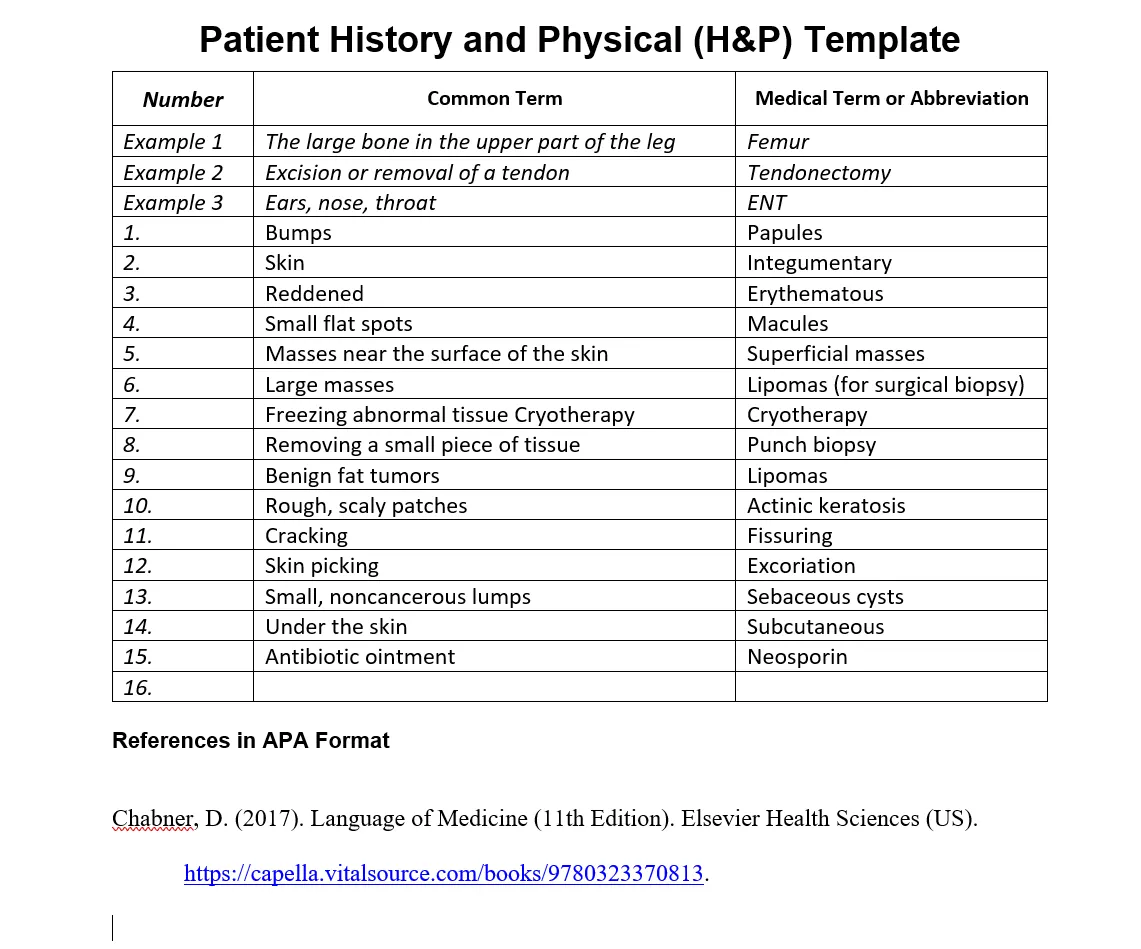
Cite the references you used to perform your translation in the correct APA style. Click Evidence and APA for additional guidance on ensuring your citations and references conform to APA guidelines.
APA Style Citations and References
As the rubric requires, we will cite the resources in APA format at the end of the HIM-FPX 4610 Assessment Two Skin Progress.
- Cite all sources used for translations in the correct APA style. This includes medical dictionaries, textbooks, and credible online resources.
- Refer to the “Evidence and APA” section for additional guidance on formatting citations and references according to APA guidelines.
Demonstration of Proficiency
By completing the HIM-FPX 4610 Assessment Two Skin Progress, you will demonstrate your proficiency in several key competencies:
Competency 2: Use medical terminology and abbreviations related to general structures and functions of the human body. Correctly identify and translate standard general structure and function terms into medical or abbreviations.
Competency 3: Use medical terminology and abbreviations related to body systems. Identify and correctly translate standard terms related to body systems into medical terms or abbreviations.
Competency 6: Spell and pronounce basic medical terms. Ensure all standard and medical terms or abbreviations are spelled correctly.
Competency 7: Communicate professionally. Provide proper citations and references in APA style.
Note: These competencies are manageable and designed to guide you through the assessment. With careful attention to detail and the use of reliable resources, you will be able to complete the task successfully.
Closing
Completing the HIM-FPX 4610 Assessment Two Skin Progress will improve your ability to translate standard terms into medical terminology and enhance your overall communication skills in a medical context. The key takeaways include understanding the importance of accurate translation, ensuring proper spelling, and adhering to APA citation guidelines. This How-To Guide will aid you with the skills essential for effective communication in healthcare and will be valuable in your future career. In the next module of HIM-FPX 4610, we will explore Assessment Three on Health Topic Approval.
HIM-FPX 4610 Assessment Three Health Topic Approval
Instructions for HIM-FPX 4610 Assessment Three Health Topic Approval
Health Topic Approval
This course has been completed, and no further assessments may be submitted.
Submit to your faculty member for review and approval three potential health topics for a 30-minute educational session for patients of a family practice office.
Collapse All
Introduction
For the final assessment of the course, you will assume the role of an office manager in a family practice office. Your office offers monthly 30-minute educational sessions for patients on a variety of topics. You have been asked to conduct next month’s presentation.
This Health Topic Approval assessment will allow you to keep your presentation in mind throughout the remainder of the course, as you will use terms from several different assessments in your presentation, and you will be evaluated on accurate medical terminology use and pronunciation.
In most cases, your physician group would likely dictate your presentation topic. For the final assessment in this course, however, you will have the opportunity to choose a topic that interests you. It does not need to be based on one of the body systems highlighted in the course assessments. For example, you may want to focus your presentation on a digestive system disease. Other topics are diabetes management, cardiac rehabilitation, diet management, or skin care. These are examples only; choose the topic of interest to you. Maybe you have a specific condition and would like to learn more about it, given all that you have learned about medical terminology throughout this course. Maybe a family member or friend has the condition.
Demonstration of Proficiency
By completing this assessment, you will demonstrate your proficiency in the following course competencies and scoring guide criteria:
- Competency 3: Use medical terminology and abbreviations related to body systems.
- Health topic approved.
Preparation
To help prepare for this assessment:
- Please review the requirements for the health topic presentation and the scoring guide criteria presented in Assessment 6 as you consider the topics that interest you most.
- You may also want to view the Health Topic Presentation for a brief example presentation.
Instructions
To ensure your topic is sufficient and appropriate for the assessment requirements, please submit three potential topics to your faculty member. They will approve one of the topics and offer feedback as necessary.
Once you receive your faculty member’s approval on your topic, you will want to begin your research. Consult the HIM-FPX4610: Medical Terminology Library Guide for help on how to begin your research and identify credible sources.
Introduction to HIM 4610 Assessment Three
In the HIM 4610 Assessment Three Health Topic Approval, you will assume the role of an office manager in a family practice office, tasked with selecting and preparing a 30-minute patient educational session. The goal is to choose a health topic that interests you, submit it for approval, and prepare a well-researched presentation. This Owlisdom How-To Guide will help you integrate and apply medical terminology learned throughout the course, ensuring clear and accurate communication.
Please submit three potential topics to your faculty member to ensure your topic is sufficient and appropriate for the assessment requirements. They will approve one of the topics and offer feedback as necessary.
Once you receive your faculty member’s approval on your topic, you will want to begin your research. Consult the HIM-FPX4610: Medical Terminology Library Guide for help starting your research and identifying credible sources.
Choosing Potential Health Topics
We will choose at least three topics to solve the HIM 4610 Assessment Three Health Topic Approval. Then, the instructor will filter out one topic that best suits the course requirements.
- Begin by brainstorming health topics that intrigue or are relevant to your experiences, family, and friends.
- Consider digestive system diseases, diabetes management, cardiac rehabilitation, diet, or skincare. These are merely suggestions; select what genuinely interests you.
- Ensure the topic is broad enough to fill a 30-minute presentation but focused enough to provide depth and detail.
- Choose topics that will engage and benefit the patients in your family practice office.
- Reflect on what you have learned in your medical terminology course to identify areas where you can demonstrate proficiency and confidence.
For the HIM 4610 Assessment Three Health Topic Approval, I am choosing:
Respiratory Health
- Managing chronic respiratory conditions (e.g., asthma, COPD)
- Importance of lung function tests and breathing exercises
- Latest treatments and innovations in respiratory care
Digestive System Diseases
- Overview of common digestive disorders (e.g., IBS, Crohn’s disease)
- Dietary recommendations for digestive health
- Impact of gut health on overall well-being
Skin Care and Dermatology
- Common skin conditions and their management
- Importance of sun protection and skin health
- Latest treatments for acne and other skin issues
Note: For sample purposes, I am going to choose Respiratory Health. Per the rubric requirements, I will use this topic for the upcoming assessments.
Submission to Faculty
- Prepare a document listing three potential health topics. Ensure each topic is clearly defined and briefly explain why it interests you and its relevance to patient education.
- Follow any specific formatting guidelines provided by your course or faculty member.
- Submit your document to your faculty member for review.
- Be open to feedback and adjust based on their recommendations.
- Once a topic is approved, you can begin your detailed research.
Beginning Research
This guide for HIM 4610 Assessment Three Health Topic Approval will help you find credible sources and relevant information for your topic.
- Access the HIM-FPX4610: Medical Terminology Library Guide for resources on how to conduct your research.
- Gather information from academic databases, medical journals, and reputable websites.
- Ensure all sources are up-to-date and relevant to your chosen topic.
Submit three potential health topics for a 30-minute educational session for patients of a family practice office to your faculty member for review and approval.
Preparing for the Presentation
Next, in HIM 4610 Assessment Three Health Topic Approval. We will prepare our presentation.
NOTE: We must make a presentation by providing a 30-minute educational session using our voiceover. As I cannot do so, I will provide tips for creating a proficient presentation for the HIM 4610 Assessment Three.
- Incorporate medical terms accurately in your presentation to demonstrate your understanding.
- Ensure that all terminology is appropriate for your audience and enhances their understanding of the topic.
- Practice pronouncing medical terms correctly to ensure clarity during your presentation.
- Utilize online resources or seek assistance from faculty if needed.
Tips
- Engage Your Audience Early: Start your voiceover with a compelling hook or exciting fact related to your health topic to grab the audience’s attention immediately.
- Clear and Concise Language: Explain complex medical terms using simple, straightforward language. Avoid jargon as much as possible to ensure your audience can easily understand the information.
- Practice Pronunciation: Practice pronouncing all medical terms correctly before recording your voiceover. Mispronouncing terms can confuse your audience and reduce your credibility.
- Use Visual Aids: Enhance your voiceover with clear, relevant slides or images illustrating key points. Visual aids can help reinforce the information and keep your audience engaged.
- Interactive Elements: Include questions or prompts for reflection throughout your presentation. This encourages active participation and helps reinforce the learning objectives.
Demonstration of Proficiency
Competency 3: Use Medical Terminology and Abbreviations Related to Body Systems:
NOTE: This competency involves accurately using medical terminology and abbreviations in your presentation. Do not stress too much about this; it is meant to guide your learning and demonstrate your ability to communicate effectively in a medical setting.
Closing
The HIM 4610 Assessment Three Health Topic Approval will enhance your ability to effectively research, understand, and communicate medical information. By choosing a topic that interests you, seeking faculty approval, conducting thorough research, and preparing a detailed presentation, you will demonstrate your proficiency in medical terminology. This How-To Guide prepares you for this assessment and equips you with skills that will be valuable in your future career in healthcare. In the next module of HIM-FPX 4610, we will explore Assessment Four on Health Topic Approval.
HIM-FPX 4610 Assessment Four Health Topic Approval
Instructions for HIM-FPX 4610 Assessment Four Health Topic Approval
Operative Report
Identify misspelled medical terms in a patient’s operative report. Use the template to correct the terms’ spelling and translate them into common terms. Write a 1–2 page paper that describes the purpose and contents of some of the types of documentation used in the HIM field. Specify the settings in which these documents would be used.
Collapse All
Introduction
In this fourth assessment, we continue our focus on medical terminology, specifically on medical terminology related to the genitourinary system. This includes the urinary system and the male and female reproductive systems. The urinary system is also known as the renal system. It is a group of organs that filter excess fluid and other blood stream substances from the body.
This assessment consists of two parts. In Part One, you will review an operative report. During this course, you have already examined a progress note and an H&P. In the operative report you review as part of this assessment, you will translate the medical terms you find into common terms. You will also correct spelling errors that appear in the report. Completing this portion of the assessment will allow you to demonstrate your knowledge of how the genitourinary system works. You will also demonstrate your knowledge of diseases, treatments, and diagnostic tests associated with this important body system.
In Part Two, you will write a 1–2 page paper that analyzes the different types of documentation in the health record. Familiarity with the contents and use of each type of documentation is an important aspect of your role as a HIM professional.
Demonstration of Proficiency
By completing this assessment, you will demonstrate your proficiency in the course competencies through the following assessment scoring guide criteria:
- Competency 2: Use medical terminology and abbreviations related to general structures and functions of the human body.
- Identify medical terms related to the general structures and functions of the human body correctly.
- Translate medical terms related to general structures and functions of the human body into common terms correctly.
- Competency 3: Use medical terminology and abbreviations related to body systems.
- Identify medical terms related to body systems correctly.
- Translate medical terms related to body systems into common terms correctly.
- Competency 5: Analyze and define medical terminology as used in health information management.
- Describe the purpose and contents of some of the types of documentation that are part of the health record.
- Identify settings where the documentation is used.
- Competency 6: Spell and pronounce basic medical terms.
- Identify misspelled medical and common terms.
- Spell medical and common terms correctly.
- Competency 7: Communicate professionally.
- Write clearly, with correct spelling, grammar, and syntax, and good organization.
- Provide citations and references in APA style.
Instructions
Part One: Operative Report
Carefully review the operative report for a patient who is having a sling replacement to treat urinary frequency and incontinence. Next, download the Operative Report Template [DOCX] and complete all of the following on the template:
- Select 15 misspelled medical terms in the operative report and place them in Column 1.
- Translate the 15 misspelled medical terms into commonly used terms in Column 2 correctly.
- Place the correctly spelled medical term in Column 3.
- Cite in correct APA style the references you used to perform your translation.
Preoperative Diagnosis: Urinary stress incontinence, cystocele.
Postoperative Diagnosis: Same.
Anesthesia: General.
History: This is a 49-year-old female with a history of a hysterectomy and bilateral oophorectomy. She complains of urinary frequency and incontinence. Options were discussed with the patient, and she decided to proceed with a sling placement. Risks of the procedure were discussed. They include hemorrhage, UTI, pielonephritis, cystitis, vaginitis, MI, DVT, PE, death, et cetera, and were deemed acceptable.
Operative Details: The patient was brought to the ER, positioned, prepped, and draped in the usual fashion. Time-out was called, and the patient's identity and the procedure being performed were validated. A Foley catheter was placed, and the bladder was drained. Allis clamps were placed on the posterior vaginal mucosa. A small incision was made, and the blader was lifted off the vaginl mucosa. The cystcele was reduced. At this time, a minor enterocele was noted. Due to the small size, the interocele was not repaired. Bilateral stab incisions were made suprapubically, and SPARC needles were placed into the suprapubic incisions and pulled through the vaginal incisions. The SPARC mesh was attached to the needles and pulled up through the incisions. The mesh was positioned against the mid-urethra, sutured into place, and cut below the surface of the skin. The skin was closed with a 4-place suture; the vaginal incision was closed with 0-Vicryl. The patient was transferred to the recovery room in stable condition.
Blood Loss: Minimal.
Part Two: HIM Terminology
Write a short, 1–2 page paper on some of the types of documentation used in the HIM field. Be sure your paper includes all of the following headings:
- Progress Note.
- History and Physical (H&P).
- Operative Report.
- Discharge Summary.
Under each heading, address each of the following:
- Describe the purpose of the document.
- Detail the contents included.
- Identify settings where the document would be used.
Consult the Capella Writing Center as needed for additional writing resources to help you write the paper portion of your assessment.
Additional Requirements
Part One: Operative Report
- Format: Ensure you complete all columns on the Operative Report Template.
- Scoring Guide: Be sure to read the scoring guide for this assessment so you understand how your faculty member will evaluate your work.
Part Two: HIM Terminology
- Written communication: Your paper does not need to be in APA format. It does need to be clear and well organized, with correct spelling, grammar, and syntax, to support orderly exposition of content.
- Title Page: You do not need to include a title page with your paper. You do need to label it HIM Terminology.
- Name: Include your name in the upper right-hand corner of your paper.
- Length: Approximately 1–2 typed and double-spaced content pages in Times New Roman, 12-point font, not including the reference page.
- References: Include a minimum of one citation of peer-reviewed sources in APA format.
Resources
This course has been completed, and no further assessments may be submitted.
Use the resources linked below to help complete this assessment.
Collapse All
Genitourinary Systems
Chabner, D. (2017). The language of medicine (11th ed.). St. Louis, MO: Saunders. Available in the course room via the VitalSource Bookshelf link.
- Chapter 7, “Urinary System,” pages 215–256.
- Chapter 8, “Female Reproductive System,” pages 257–310.
- Chapter 9, “Male Reproductive System,” pages 311–342.
The Endocrine System
Chabner, D. (2017). The language of medicine (11th ed.). St. Louis, MO: Saunders. Available in the course room via the VitalSource Bookshelf link.
- Chapter 18, “Endocrine System,” pages 749–798.
Word Structure
Chabner, D. (2017). The language of medicine (11th ed.). St. Louis, MO: Saunders. Available in the course room via the VitalSource Bookshelf link.
- Appendix I, “Plurals,” page 981.
Health Information Management (HIM) Terminology
- Casto, A., Koehler, M., & Lockwood, F. (2017). Clinical terminology: Expanding career pathways for HIM professionals. Journal of AHIMA, 88(9), 50–55.
- Russo, R. (2004, October). Documentation and data improvement fundamentals. IFHRO congress & AHIMA convention proceedings. Retrieved from http://bok.ahima.org/doc?oid=60174#.Wl95E66nGUk
Additional Resources for Further Exploration
While this course has focused on medical terminology, keep in mind that the health care field expands beyond medical terminology. For example, the health information management field has terminology related to reimbursement, documentation, and the electronic health record. The Oachs and Watters textbook—an optional resource for this course—is a great place to learn more about this terminology.
Oachs, P. K., & Watters, A. L. (2016). Health information management: Concepts, principles, and practice (5th ed.). Chicago, IL: AHIMA Press. Available in the course room via the VitalSource Bookshelf link.
- Chapter 4, “Health Record Content and Documentation,” pages 97–140.
- Chapter 5, “Clinical Classifications, Vocabularies, Terminologies, and Standards,” pages 141–168.
Activity
Click Activity: The Genitourinary System to complete an interactive activity that will enable you to practice the medical terminology associated with the male and female genitourinary systems and assess your knowledge of these important body systems. This additional practice will serve you well as you complete your assessment on this body system. Have fun and good luck.
This tool needs to be loaded in a new browser window
Introduction to HIM 4610 Assessment Four
This Owlisdom How-To Guide aims to assist students in completing an assignment focused on medical terminology, particularly related to the genitourinary system. The HIM 4610 Assessment Four Health Topic Approval involves reviewing an operative report, correcting and translating medical terms, and writing a short paper on health information management (HIM) documentation. This How-To Guide aims to demonstrate proficiency in identifying, translating, and correctly spelling medical terms and understanding different types of HIM documentation.
Select 15 misspelled medical terms in the operative report and place them in Column 1.
Correctly translate the 15 misspelled medical terms into commonly used terms in Column 2.
Place the correctly spelled medical term in Column 3.
Cite in the correct APA style the references you used to perform your translation.
Part One: Operative Report
For Part One of the HIM 4610 Assessment Four Health Topic Approval, we will find misspelled medical terms in the patient’s report and fill out the provided template. I am using the template by Capella University as an example.
- Review the Operative Report: Carefully read through the entire operative report to understand the context and identify any medical terms that may be misspelled.
- Identify Misspelled Medical Terms: Select 15 misspelled medical terms. Look for standard medical terms that seem incorrect or out of place.
- Translate Medical Terms: Translate each of the 15 misspelled medical terms into standard terms that are easily understandable by non-medical professionals. Use reliable medical dictionaries or online medical resources.
- Correct Spelling of Medical Terms: Provide the correct spelling for the identified misspelled medical terms. Double-check medical references to ensure accuracy.
- Cite References in APA Style: Cite the references you used to translate and correct the medical terms using APA style. For guidance on proper citation format, refer to the latest APA manual or online resources.
Example
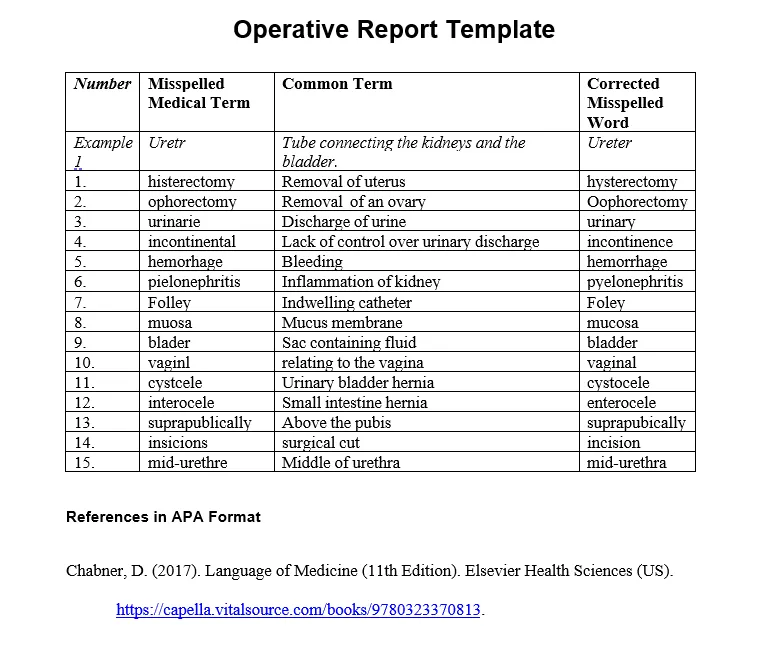
Part Two: HIM Terminology Paper
Progress Note
Now, in HIM 4610 Assessment Four Health Topic Approval. We will describe how a progress note records a patient’s ongoing care and progress.
- Contents Included: Detail the typical contents, such as patient updates, clinical observations, and treatment plans.
- Settings of Use: Identify settings where progress notes are commonly used, such as hospitals and clinics.
History and Physical (H&P)
Here, in HIM 4610 Assessment Four Health Topic Approval. We will explain that an H&P document provides a comprehensive overview of the patient’s medical history and physical condition.
- Contents Included: Outline the contents, including patient history, physical examination findings, and initial diagnostic impressions.
- Settings of Use: Mention that H&P documents are used in various healthcare settings, including hospitals, outpatient clinics, and specialty care centers.
Operative Report
In HIM 4610 Assessment Four Health Topic Approval, the purpose of the Document is to describe an operative report that details the surgical procedure performed, including the steps taken and outcomes.
- Contents Included: List contents such as patient identification, preoperative diagnosis, surgical procedure, and postoperative diagnosis.
- Settings of Use: Indicate that operative reports are used in surgical settings, including hospitals and outpatient surgical centers.
Discharge Summary
Purpose of the Document: Explain that a discharge summary provides a summary of the patient’s hospital stay and instructions for post-discharge care.
Contents Included: Detail the contents, such as patient discharge condition, medications prescribed, follow-up instructions, and recommendations.
Settings of Use: Identify settings where discharge summaries are used, such as hospitals and rehabilitation centers.
Demonstration of Proficiency
Competency 2: Demonstrate the ability to identify and translate medical terms related to general structures and functions of the human body.
Competency 3: Show proficiency in identifying and translating medical terms related to body systems.
Competency 5: Analyze and define medical terminology in health information management, describing the purpose and contents of various documentation types.
Competency 6: Correctly identify and spell medical and standard terms.
Competency 7: Communicate professionally, ensuring clear writing, correct spelling, grammar, and proper APA citation.
Closing
Completing this HIM 4610 Assessment Four Health Topic Approval will enhance your understanding and proficiency in medical terminology, particularly concerning the genitourinary system. You will develop essential skills required in healthcare by identifying and correcting misspelled medical terms, translating them into everyday terms, and analyzing HIM documentation. Remember, the competencies outlined are designed to guide you through the assessment, ensuring a thorough understanding and practical application of medical terminology. In the next module of HIM-FPX 4610, we will explore Assessment Five on the Cardiorespiratory System.
HIM-FPX 4610 Assessment Five: The Cardiorespiratory System
Instructions of HIM-FPX 4610 Assessment Five: The Cardiorespiratory System
Discharge Summary: The Cardiorespiratory System
Translate into medical terms or abbreviations the common terms contained in a patient’s discharge summary. Identify five drugs appearing in the discharge summary and specify the usage reason for each drug on the provided template. Record yourself reading the patient’s discharge summary (1–2 single-spaced pages).
Collapse All
Introduction
Assessment 5 continues the exploration of medical terminology related to various body systems and the general structure and functions of the human body. In this assessment, you will focus your attention on the cardiorespiratory system, a specialized area of medicine. The cardiorespiratory system refers to the ability of the circulatory and respiratory systems to supply oxygen to skeletal muscles during sustained physical activity. You will have an opportunity to demonstrate your knowledge of this system’s purpose, various parts, and importance to overall body functioning. In addition, you will demonstrate your knowledge of cardiorespiratory diseases, diagnostic studies, and treatments, including pharmacology.
In the assessment, you will review a discharge summary for a patient with cardiorespiratory disease and demonstrate your command of medical terminology, including your pronunciation of the terms, through an audio recording.
Demonstration of Proficiency
By completing this assessment, you will demonstrate your proficiency in the course competencies through the following assessment scoring guide criteria:
- Competency 1: Use medical terminology and abbreviations related to pharmacology.
- Identify drugs correctly.
- Specify the correct reason for the drug’s use.
- Competency 2: Use medical terminology and abbreviations related to general structures and functions of the human body.
- Identify common terms related to the general structures and functions of the human body correctly.
- Translate common terms related to general structures and functions of the human body into medical terms or abbreviations correctly.
- Competency 3: Use medical terminology and abbreviations related to body systems.
- Identify common terms related to body systems correctly.
- Translate common terms related to body systems into medical terms or abbreviations correctly.
- Competency 4: Use medical terminology and abbreviations related to specialized areas of medicine.
- Identify common terms related to specialized areas of medicine correctly.
- Translate common terms related to specialized areas of medicine into medical terms or abbreviations correctly.
- Competency 6: Spell and pronounce basic medical terms.
- Spell common and medical terms or abbreviations correctly.
- Pronounce medical terms correctly.
- Competency 7: Communicate professionally.
- Use volume, tone, and clarity reflective of professional communication in a healthcare setting.
- Provide citations and references in APA style.
Preparation
To prepare for your audio recording of the discharge summary:
- Set up and test your microphone or headset using the installation instructions provided by the manufacturer.
- Practice using the equipment to ensure the audio quality is sufficient.
- Consult Using Kaltura [PDF] for guidance on how to record your discharge summary and upload it to the courtroom.
Note: If you require the use of assistive technology or alternative communication methods to participate in this activity, please contact Disability Services to request accommodations.
Instructions
Review the patient’s discharge summary below. Next, download the Discharge Summary Template [DOCX] and complete all of the following:
- Identify ten common terms contained in the discharge summary and correctly translate them into medical terms or abbreviations. Remember, you must spell the common and medical terms or abbreviations correctly.
- Identify five drugs that appear in the discharge summary and specify the reason each drug is used.
- Cite in the correct APA style the references you used to perform your translation.
The final step in this assessment is to record yourself reading the discharge summary with the correct medical terms. In your recording, you must correctly pronounce all the medical terms. In addition, be sure to use appropriate tone, volume, and clarity for professional communication in the health care field. Submit your Discharge Summary Template and your audio recording of the discharge summary to the appropriate area in the courtroom.
Discharge Summary: Cardiorespiratory
Discharge Diagnosis
- Non-ST-elevation myocardial infarction.
- Moderate coronary artery disease.
- Stroke.
- High blood pressure.
- An abnormally high concentration of lipids in the blood.
- Chronic obstructive pulmonary disease.
- Chronic systolic congestive heart failure.
Procedures
Left heart catheterization, a medical imaging test to determine cardiac function in the left ventricle, medical imaging used to visualize coronary arteries with stent placement. Computed tomography scan, magnetic resonance imaging scan, and posterior artery in the brain with stent placement.
Brief History
This 72-year-old male presented to the emergency room with chest pain, shortness of breath, and left arm numbness. The patient has a history of high blood pressure, an abnormally high concentration of lipids in the blood, chronic obstructive pulmonary disease, and congestive heart failure. In the emergency room, troponin levels and EKG results came back positive for non-ST-elevation myocardial infarction. The patient was taken directly to the cardiac catheterization lab.
Past Medical History
High blood pressure, an abnormally high concentration of lipids in the blood, chronic obstructive pulmonary disease, congestive heart failure, asthma as a child, and a previous right total knee replacement.
Medications
Norvasc, Lipitor, Lasix, Cozaar, oxygen dependent.
Family History
The patient is adopted and does not know family history; all children are healthy.
Social History
Former smoker, no alcohol or illegal drugs.
Allergies
Penicillin, Sulfa.
Physical Exam
GENERAL: Alert and oriented X3.
HEENT: Normocephalic and atraumatic, blindness over half the field of vision.
LUNGS: Few rales in the lower lobes.
HEART: R without a murmur.
ABDOMEN: Soft, non-tender, without swelling or masses.
EXTREMITIES: 2+ edema in lower extremities, no cyanosis.
Hospital Course
This is a 72-year-old male who was taken directly to the cardiac catheterization lab from the emergency department due to an evolving non-ST-elevation myocardial infarction. A 98% closure of the centre-right coronary artery lesion was treated with a Cypher 3.5 x 13 mm stent. The left descending artery showed 35% stenosis, and the left circumflex artery showed 25% stenosis. The image of the left ventricle demonstrated an ejection fraction of 40%. Following the procedure, the patient was admitted to the telemetry unit for observation. He remained in stable condition without chest pain but developed an irregular, rapid heartbeat. The next day, the patient complained of a severe headache in the back of his head with double vision and was able to see from half of his eye. The patient was taken for a computed tomography scan and magnetic resonance imaging scan, which showed a blood clot blocking the posterior artery in the brain. The patient was taken back to the catheterization room, where a catheterization of the head artery was performed to remove the blood clot and to place a stent to keep the vessel open. The patient is being discharged home on routine meds to follow up with a primary care physician within seven days.
Additional Requirements
- Format: Be sure to complete all columns on the Discharge Summary Template.
- Submission: Be sure to submit all of the following to the appropriate area in the courtroom:
- The Discharge Summary Template.
- Your audio recording of the discharge summary.
- Scoring Guide: Be sure to read this assessment’s scoring guide so you understand how your faculty member will evaluate your Discharge Summary Template and your audio recording.
Resources
This course has been completed, and no further assessments may be submitted.
Use the resources linked below to help complete this assessment.
Collapse All
The Cardiovascular System
Chabner, D. (2017). The language of medicine (11th ed.). St. Louis, MO: Saunders. Available in the courtroom via the VitalSource Bookshelf link.
- Chapter 11, “Cardiovascular System,” pages 399–458.
- Chapter 13, “Blood System,” pages 503–546.
- Chapter 14, “Lymphatic and Immune Systems,” pages 547–578.
The Respiratory System
Chabner, D. (2017). The language of medicine (11th ed.). St. Louis, MO: Saunders. Available in the courtroom via the VitalSource Bookshelf link.
- Chapter 12, “Respiratory System,” pages 459–502.
Word Structure
Chabner, D. (2017). The language of medicine (11th ed.). St. Louis, MO: Saunders. Available in the courtroom via the VitalSource Bookshelf link.
- Appendix II, “Abbreviations, Acronyms, Eponyms, and Symbols,” pages 982–993.
Activity
Click Vila Health: Medical Terminology to complete an interactive activity in which you will hear an interaction between two healthcare professionals about a patient’s chart. Access the Cardiovascular tab. This activity will help you assess how well you know the medical terminology associated with the cardiovascular system and also help prepare you to complete your assessment.
This tool needs to be loaded in a new browser window
Introduction to HIM-FPX 4610 Assessment Five
You will use medical terminology in the HIM-FPX 4610 Assessment Five: The Cardiorespiratory System, specifically focusing on the cardiorespiratory system. Your tasks include translating standard terms from a patient’s discharge summary into medical terms or abbreviations, identifying drugs and their usage, citing your sources in APA style, and recording yourself reading the summary with accurate pronunciation. This Owlisdom How-To Guide will enhance your understanding of medical language, which is crucial for effective communication in healthcare settings.
Review the Patient’s Discharge Summary
To start the HIM-FPX 4610 Assessment Five: The Cardiorespiratory System, we will first study the patient’s history and summary of discharge.
- Carefully read the provided patient’s discharge summary.
- Highlight or note down standard terms that need translation.
- Familiarize yourself with the context and overall content of the summary.
Identify ten common terms in the discharge summary and correctly translate them into medical terms or abbreviations. Remember to spell the common and medical terms or abbreviations correctly.
Translate Common Terms to Medical Terms or Abbreviations
Next, in HIM-FPX 4610 Assessment Five: The Cardiorespiratory System. We will translate ten common terms into medical terms.
- Identify ten standard terms from the discharge summary.
- Use reliable medical dictionaries or textbooks to find the corresponding medical terms or abbreviations.
- Ensure both standard terms and their medical equivalents are spelled correctly.
- Write these translations in the provided template.
Identify five drugs in the discharge summary and specify why each is used.
Identify and Explain the Usage of Five Drugs
After identifying the terms in HIM-FPX 4610 Assessment Five: The Cardiorespiratory System. We will specify five drugs used and their usage.
- Identify five drugs mentioned in the discharge summary.
- Research each drug to understand its purpose and usage.
- Document the drug names and their reasons for usage in the provided template.
- Make sure your explanations are concise and accurate.
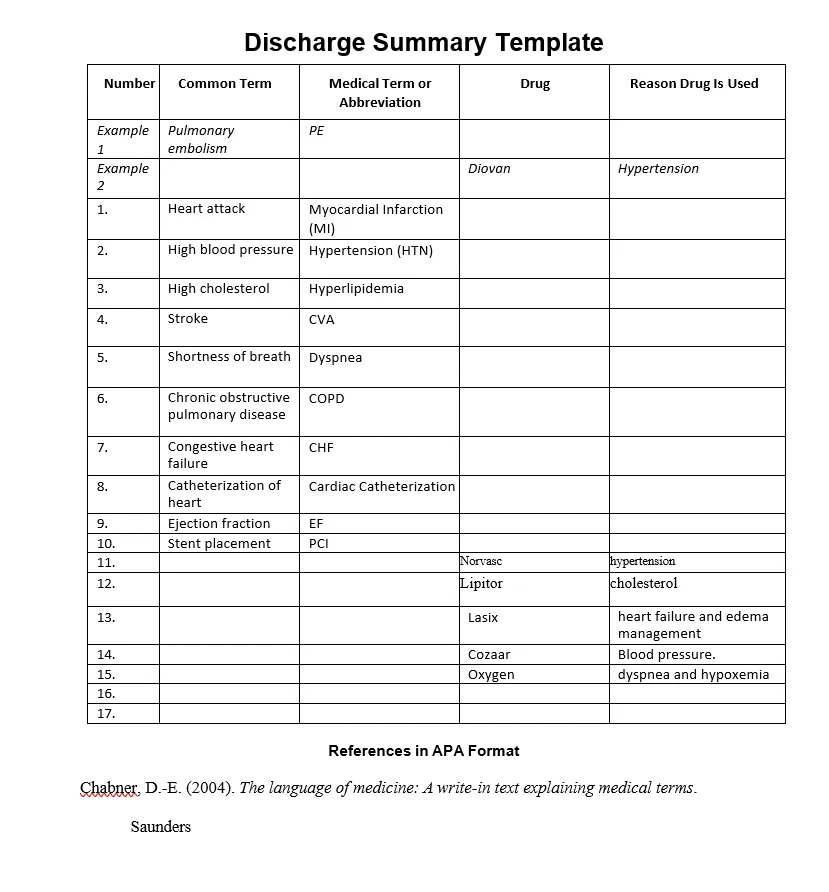
Cite in the correct APA style the references you used to perform your translation.
Cite References in APA Style
Finally, in HIM-FPX 4610 Assessment Five: The Cardiorespiratory System. We will cite the used resources using the APA citation style.
- Use credible sources for your translations and drug usage explanations.
- Format your citations and references in APA style.
- Include in-text citations within your template and a reference list at the end.
The final step in this assessment is to record yourself reading the discharge summary with the correct medical terms. In your recording, you must correctly pronounce all the medical terms.
Record and Pronounce the Discharge Summary
Along with the solved template of the HIM-FPX 4610 Assessment Five: The Cardiorespiratory System, we will also submit a video presentation explaining the patient’s discharge summary.
- Practice pronouncing all medical terms accurately before recording.
- Ensure your recording is straightforward, using the appropriate tone and volume.
- Aim for a professional level of communication.
- Record yourself reading the discharge summary, focusing on correct pronunciation and clarity.
Demonstration of Proficiency
- Use Medical Terminology and Abbreviations Related to Pharmacology
- Correctly identify drugs and specify their usage.
- Use Medical Terminology and Abbreviations Related to General Structures and Functions of the Human Body
- Translate terms related to general body functions accurately.
- Use Medical Terminology and Abbreviations Related to Body Systems
- Identify and translate terms related to body systems.
- Use Medical Terminology and Abbreviations Related to Specialized Areas of Medicine
- Translate specialized medical terms correctly.
- Spell and Pronounce Basic Medical Terms
- Ensure correct spelling and pronunciation of medical terms.
- Communicate in a Professional Manner
- Use appropriate volume, tone, and clarity in communication.
- Provide citations and references in APA style.
Note: These competencies are designed to guide you through the assessment. While they may seem challenging, they enhance your skills in medical terminology and professional communication. Approach each competency step-by-step, and you’ll be able to complete the HIM-FPX 4610 Assessment Five: The Cardiorespiratory System effectively.
Closing
The HIM-FPX 4610 Assessment Five: The Cardiorespiratory System is a comprehensive exercise in mastering medical terminology related to the cardiorespiratory system. You will develop a strong foundation in medical language by translating standard terms, identifying drug usage, citing references, and recording your pronunciation. This How-To Guide enhances the skills essential for accurate and effective communication in the healthcare field, ensuring clarity and precision in patient care documentation. In the next module of HIM-FPX 4610, we will explore Assessment Six on Health Topic Presentation.
HIM-FPX 4610 Assessment Six: Health Topic Presentation
Instructions for HIM-FPX 4610 Assessment Six: Health Topic Presentation
Health Topic Presentation
This course has been completed, and no further assessments may be submitted.
Record a 30-minute slide presentation (10–15 slides) on a health topic of your choosing to present to patients of a family practice clinic.
Collapse All
Introduction
In this final assessment, remember that you are assuming the role of a family practice office manager. Your office offers monthly 30-minute educational sessions for patients on various topics. You have been allowed to present at next month’s session.
In Assessment 3, your faculty member approved your topic and provided you with feedback on it. Since then, you have been using credible resources to research your health topic. For this assessment, you are to prepare your slide presentation with speaker’s notes for your educational session. You will also submit an audio recording and a transcript of your presentation.
Demonstration of Proficiency
By completing this assessment, you will demonstrate your proficiency in the course competencies through the following assessment scoring guide criteria:
- Competency 1: Use medical terminology and abbreviations related to pharmacology.
- Apply medical terminology related to pharmacology or other treatments to a health topic.
- Competency 2: Use medical terminology and abbreviations related to general structures and functions of the human body.
- Apply medical terminology related to the structure and functions of the human body to a health topic.
- Competency 3: Use medical terminology and abbreviations related to body systems.
- Apply medical terminology related to human body systems to a health topic.
- Competency 4: Use medical terminology and abbreviations related to specialized areas of medicine.
- Apply medical terminology related to a specialized area of medicine, including diagnostic or surgical procedures, to a health topic.
- Competency 5: Analyze and define medical terminology as used in health information management.
- Apply medical terminology used in health information management.
- Competency 6: Spell and pronounce basic medical terms.
- Pronounce medical terms properly.
- Spell medical terms correctly.
- Competency 7: Communicate professionally.
- Create a presentation that is clearly written, organized, and generally free of grammatical errors.
- Provide title and reference slides that conform to APA style and format.
- Use volume, tone, and clarity reflective of professional communication in a health care setting.
Preparation
To prepare for this assessment:
- Click Health Topic Presentation to view a media piece that provides a brief example of a presentation.
- Complete your research on the health topic of your presentation. Consult the HIM-FPX4610: Medical Terminology Library Guide for research tips and help in identifying credible resources.
- Consult the Capella Writing Center as needed for additional writing resources to help you develop your presentation.
To prepare for the audio recording of your presentation:
- Set up and test your microphone or headset using the installation instructions provided by the manufacturer. You only need to use the headset if your audio is not clear and high-quality when captured by the microphone.
- Practice using the equipment to ensure the audio quality is sufficient.
- Microsoft PowerPoint allows you to record your narration with your slides. If you choose to record your presentation using this tool, simply submit your presentation to the appropriate area of the course room. Your narration will be included with your slides.
- Consult Using Kaltura [PDF] for guidance in how to record your presentation and upload it to the course room if you elect not to use Microsoft PowerPoint to submit your slides and narration.
Note: If you require the use of assistive technology or alternative communication methods to participate in this activity, please contact Disability Services to request accommodations.
Instructions
Your presentation needs to begin with a definition and description of your topic. Next, be sure to address all of the following:
- Causes.
- Signs and symptoms.
- At-risk population(s).
- Prognosis.
- Diagnostic or surgical procedures.
- Treatment protocols, including pharmacological treatments.
- Support systems.
- Prevention.
In addition, your presentation will need to include 3–5 HIM terms related to your topic. Please provide a professional yet memorable title slide and a reference slide that lists the references you consulted when developing your presentation. Also, please ensure your title and reference slides conform to APA style and formatting guidelines.
After developing your presentation, delivering it, and audio recording it, submit all of the following to the appropriate area in the course room:
- Your 10–15 slides with speaker’s notes, including title and reference slides in APA format.
- Your audio recording of your presentation.
- A transcript of your presentation.
Additional Requirements
- Writing: Your presentation does not need to conform to APA style and formatting guidelines. It does need to be clear, well-organized, and generally free of grammatical errors. You do need to provide a title and reference slides that conform to APA style and format.
- Length: Your presentation is not to exceed 30 minutes in length.
- Scoring Guide: Be sure to read this assessment’s scoring guide so you understand how your faculty member will evaluate your work.
Resources
This course has been completed, and no further assessments may be submitted.
Use the resources linked below to help complete this assessment.
Collapse All
Specialized Areas of Medicine
Chabner, D. (2017). The language of medicine (11th ed.). St. Louis, MO: Saunders. Available in the course room via the VitalSource Bookshelf link.
- Chapter 19, “Cancer Medicine (Oncology),” pages 799–848.
- Chapter 20, “Radiology and Nuclear Medicine,” pages 849–880.
- Chapter 21, “Pharmacology,” pages 881–920.
Research, Writing, and APA Style and Format
As you prepare to develop and deliver your presentation on your chosen health topic, please consider these resources as needed:
Note: Your presentation does not need to conform to APA style and formatting guidelines. It does need to be clear, concise, organized, and well-written. Your title and references slides do, however, need to conform to APA guidelines. Consult Evidence and APA if you need a refresher.
Additional Resources for Further Exploration
While this course has focused on medical terminology, keep in mind that the health care field expands beyond medical terminology. For example, the health information management field has terminology related to reimbursement, documentation, and the electronic health record. The Oachs and Watters textbook—an optional resource for this course—is a great place to learn about this terminology.
Oachs, P. K., & Watters, A. L. (2016). Health information management: Concepts, principles, and practice (5th ed.). Chicago, IL: AHIMA Press. Available in the course room via the VitalSource Bookshelf link.
- Chapter 5, “Clinical Classifications, Vocabularies, Terminologies, and Standards,” pages 141–168.
Activity
This course has been completed, and no further assessments may be submitted.
Click Vila Health: Medical Terminology to complete an interactive activity in which you will hear an interaction between a nurse and a home health care agency about a patient’s aftercare. Access the Procedures tab. This activity will give you additional practice in using medical terminology associated with various medical procedures and help you prepare to give your presentation.
This tool needs to be loaded in a new browser window
Introduction to HIM-FPX 4610 Assessment SIX
In the HIM-FPX 4610 Assessment Six: Health Topic Presentation, you will assume the role of a family practice office manager and present an educational session on the cardiorespiratory system. This Owlisdom How-To Guide will showcase your knowledge of medical terminology, particularly concerning the circulatory and respiratory systems, their functions, and related diseases. You will create a slide presentation with speaker notes, record your presentation, and submit the slides, audio recording, and transcript.
For this assessment, you must prepare your slide presentation for your educational session.
Creating the Slide Presentation
We will prepare the presentation to start the HIM-FPX 4610 Assessment Six: Health Topic Presentation. I am choosing the topic “Obesity” for this assessment.
Definition and Description of the Topic: Start with a clear definition and description of the cardiorespiratory system and its importance.
Causes: Research and list the primary causes of cardiorespiratory diseases.
Signs and Symptoms: Identify and describe common signs and symptoms of cardiorespiratory conditions.
At-risk Populations: Highlight populations that are at higher risk for cardiorespiratory diseases.
Prognosis: Discuss the prognosis for patients with cardiorespiratory conditions.
Diagnostic or Surgical Procedures: Explain standard diagnostic and surgical procedures for treating cardiorespiratory diseases.
Treatment Protocols, Including Pharmacology Treatments: Outline standard treatment protocols and include information on pharmacology treatments.
Support Systems: Mention the support systems available for patients with cardiorespiratory conditions.
Prevention: Provide tips and strategies for preventing cardiorespiratory diseases.
Including Health Information Management (HIM) Terms
- Incorporate 3-5 HIM terms related to the cardiorespiratory system into your presentation.
- Define and explain these terms in the context of your topic.
Title and Reference Slides
- Create a professional title slide that indicates the topic of your presentation.
- Compile a reference slide listing all sources used, formatted according to APA guidelines.
Recording and Submitting Your Presentation
- Use Microsoft PowerPoint or Kaltura to record your presentation with your narration.
- Ensure your audio is clear and professional.
- Submit your slides, audio recording, and transcript to the appropriate area in the course room.
Demonstration of Proficiency
- Competency 1: Use medical terminology related to pharmacology.
- Competency 2: Use medical terminology related to the structures and functions of the human body.
- Competency 3: Use medical terminology related to body systems.
- Competency 4: Use medical terminology related to specialized areas of medicine.
- Competency 5: Analyze and define medical terminology in health information management.
- Competency 6: Spell and pronounce medical terms correctly.
- Competency 7: Communicate professionally.
Note: These competencies are straightforward and designed to help you effectively apply your knowledge of medical terminology. Approach them step-by-step, and you’ll find that they reinforce your learning and understanding of the HIM-FPX 4610 Assessment Six: Health Topic Presentation material.
Closing
The HIM-FPX 4610 Assessment Six: Health Topic Presentation is an opportunity to demonstrate your understanding of the cardiorespiratory system and your ability to communicate medical information clearly and professionally. Following this How-To Guide and focusing on the key areas will create a comprehensive and informative presentation highlighting your medical terminology expertise. You can also read the HIM-FPX 4610 complete modules to ace the course!
References
Aaseth, J., Ellefsen, S., Alehagen, U., Sundfør, T. M., & Alexander, J. (2021). Diets and drugs for weight loss and health in obesity—An update. Biomedicine & Pharmacotherapy = Biomedicine & Pharmacotherapy, 140, 111789. https://doi.org/10.1016/j.biopha.2021.111789
Avenell, A., Broom, J., Brown, T. J., Poobalan, A., Aucott, L., Stearns, S. C., Smith, W. C. S., Jung, R. T., Campbell, M. K., & Grant, A. M. (2004). A systematic review of the long-term effects and economic consequences of treatments for obesity and implications for health improvement. Health Technology Assessment (Winchester, England), 8(21), iii–iv, 1–182. https://doi.org/10.3310/hta8210
Klein, S., Gastaldelli, A., Yki-Järvinen, H., & Scherer, P. E. (2022). Why does obesity cause diabetes? Cell Metabolism, 34(1), 11–20.
Sarma, S., Sockalingam, S., & Dash, S. (2021). Obesity as a multisystem disease: Trends in obesity rates and obesity‐related complications. Diabetes, Obesity and Metabolism, 23, 3–16.
Sørensen, T. I., Martinez, A. R., & Jørgensen, T. S. H. (2022). Epidemiology of obesity. In From Obesity to Diabetes (pp. 3–27). Springer.
Tzenios, N. (2023). Obesity is a risk factor for different types of cancer. EPRA International Journal of Research and Development (IJRD), 8(2), 97–100.
WHO. (2024). Obesity and overweight. https://www.who.int/news-room/fact-sheets/detail/obesity-and-overweight
Speaker’s Notes
Slide 1 Title Slide
Welcome to my presentation on understanding obesity. Today, we will explore the causes, symptoms, treatments, and prevention strategies related to obesity. This presentation aims to comprehensively overview this significant public health issue and highlight practical ways to manage and prevent obesity.
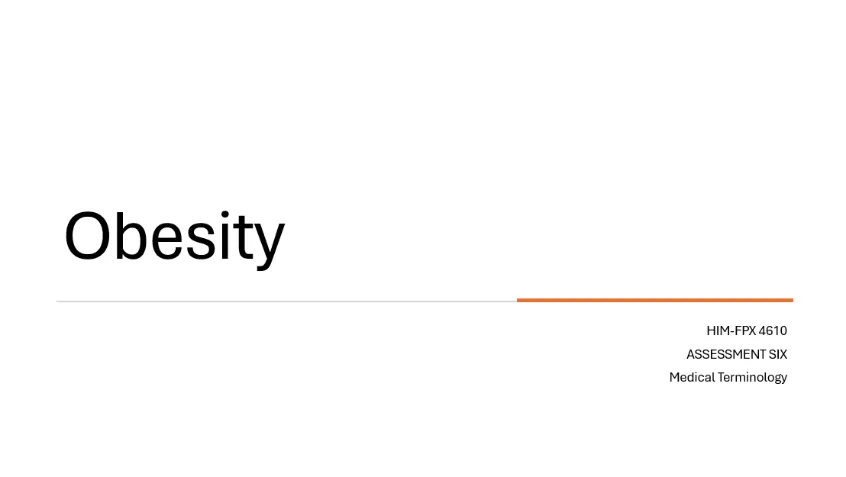
Slide 2: Definition and Description
Obesity is having excessive body fat, typically measured using Body Mass Index (BMI). A BMI of 30 or higher classifies an individual as obese. This condition poses serious health risks and significantly impacts overall well-being. Understanding obesity is crucial for developing effective prevention and management strategies.
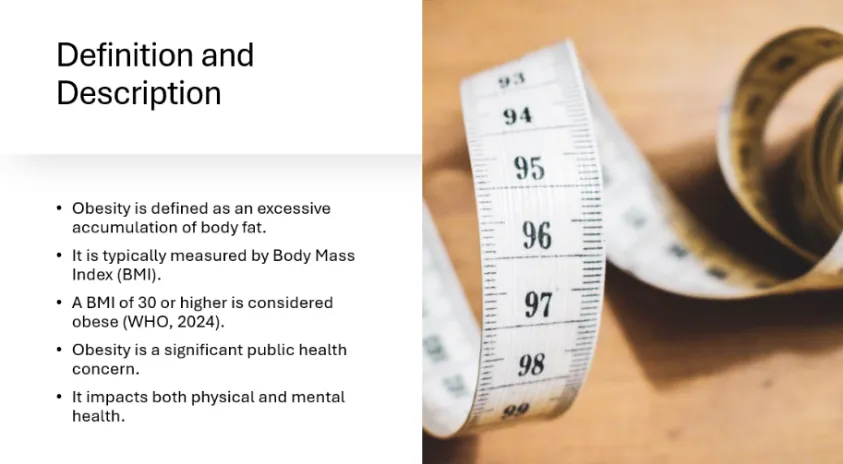
Slide 3: Importance of Understanding Obesity
Understanding obesity is essential due to its wide-ranging health implications. It affects the cardiorespiratory system and increases the risk of chronic diseases like diabetes and heart disease. By raising awareness and understanding, we can develop better prevention strategies and improve overall health outcomes.
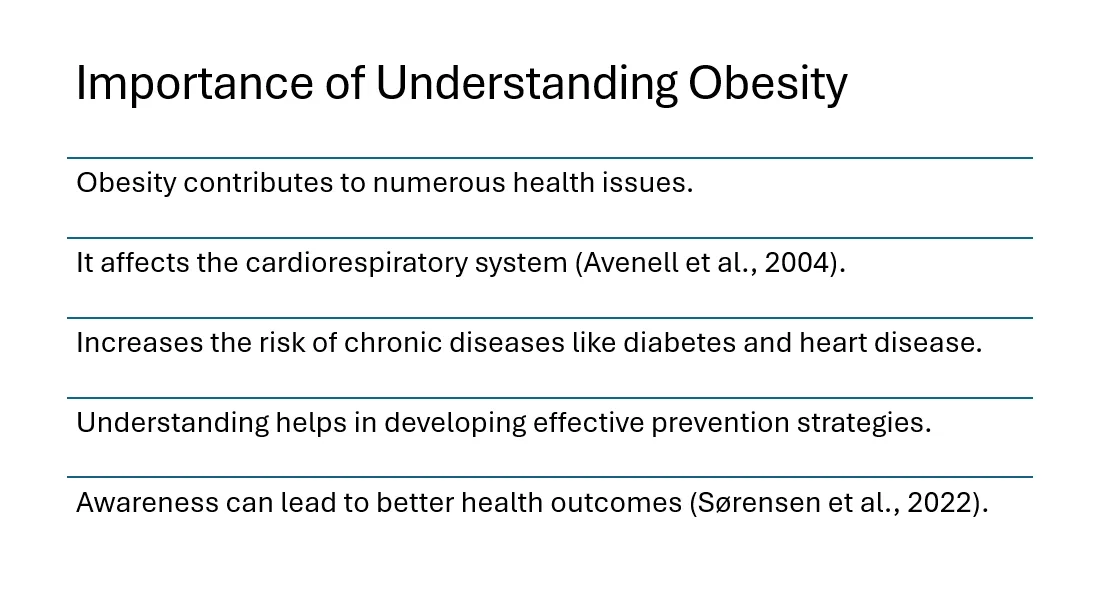
Slide 4: Causes of Obesity
The primary causes of obesity include genetic factors, poor diet, lack of physical activity, environmental influences, and metabolic factors. Each of these elements plays a significant role in the development of obesity, making it a multifaceted condition requiring comprehensive intervention strategies.
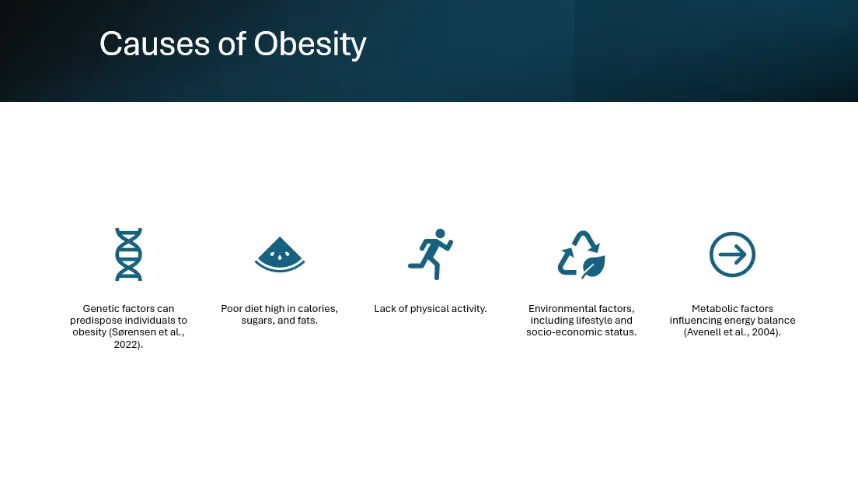
Slide 5: Genetic Factors
Genetic predisposition significantly impacts obesity. Family history can increase the risk, with specific genes affecting appetite and metabolism. Understanding the genetic component is vital for creating personalized interventions and highlighting the need for targeted prevention measures.

Slide 6: Lifestyle Factors
Lifestyle factors, such as a sedentary lifestyle and high-calorie diets, significantly contribute to obesity. Lack of regular physical activity, stress, and social influences exacerbate the condition. Addressing these factors through lifestyle changes is crucial for effective obesity management.

Slide 7: Signs and Symptoms
Common signs and symptoms of obesity include increased BMI, visible fat accumulation, fatigue, difficulty performing physical activities, and breathlessness. Recognizing these symptoms early is vital for timely intervention and management to prevent further health complications.
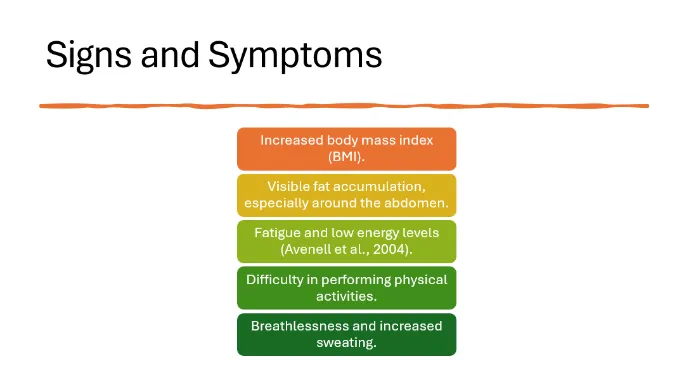
Slide 8: At-risk Populations
Populations at higher risk for obesity include children, low-income groups, individuals with certain medical conditions, sedentary professionals, and specific ethnic groups with higher genetic predispositions. Targeted interventions and awareness programs can help mitigate risks in these vulnerable populations.
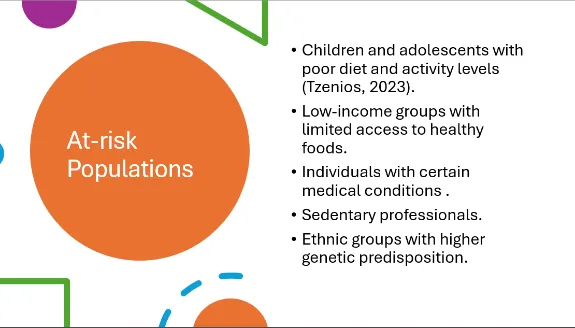
Slide 9: Prognosis of Obesity
The prognosis of obesity includes potential chronic health conditions, increased risk of cardiovascular diseases, type 2 diabetes, and a negative impact on the quality of life. Long-term management and lifestyle changes are essential to improve the prognosis and overall health outcomes.
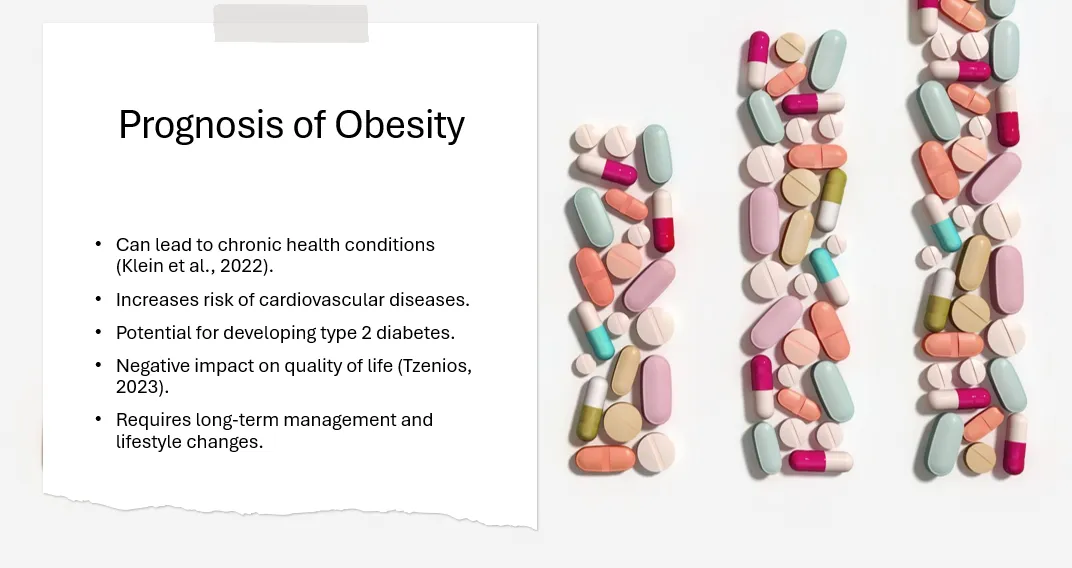
Slide 10: Diagnostic Procedures
Obesity is diagnosed through BMI calculation, waist circumference measurement, health assessments, blood tests, and imaging tests to evaluate body fat distribution. Accurate diagnosis is crucial for developing effective treatment plans tailored to individual needs.
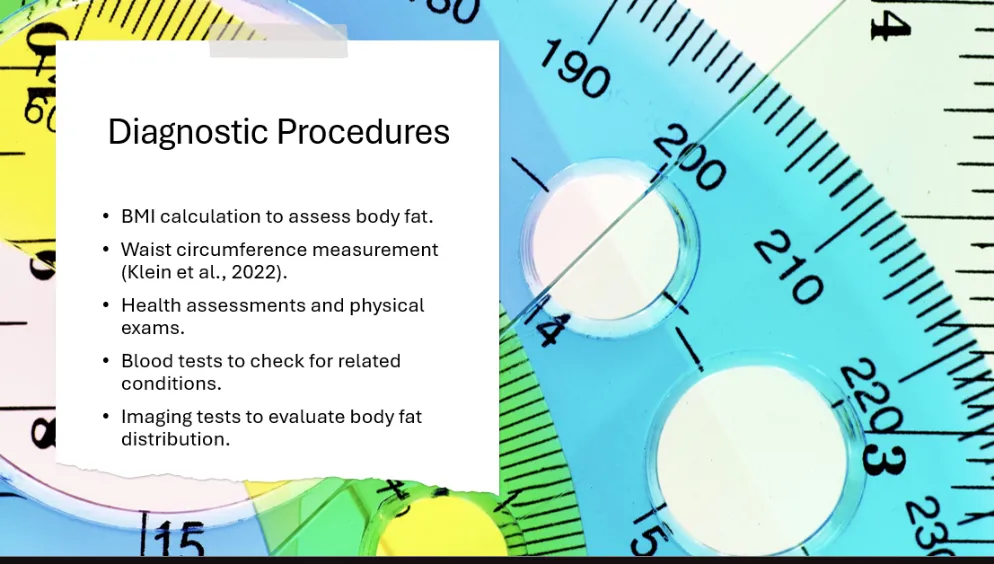
Slide 11: Surgical Procedures
Surgical interventions for obesity include bariatric surgery, gastric bypass, sleeve gastrectomy, adjustable gastric banding, and occasionally liposuction. These procedures are typically considered when other treatments have failed and are crucial for severe obesity management.
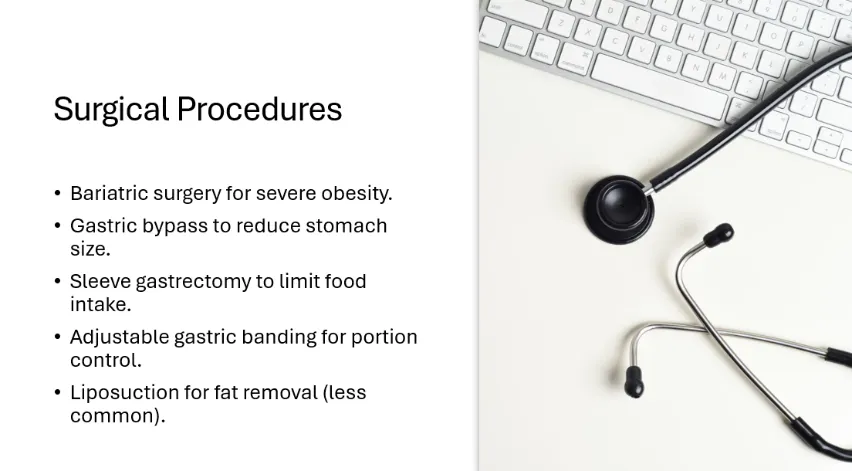
Slide 12:Treatmentt Protocols
Standard treatment protocols for obesity involve dietary modifications, increased physical activity, behavioral therapy, medications, and regular monitoring. A comprehensive approach ensures long-term effectiveness and helps individuals achieve and maintain a healthy weight.
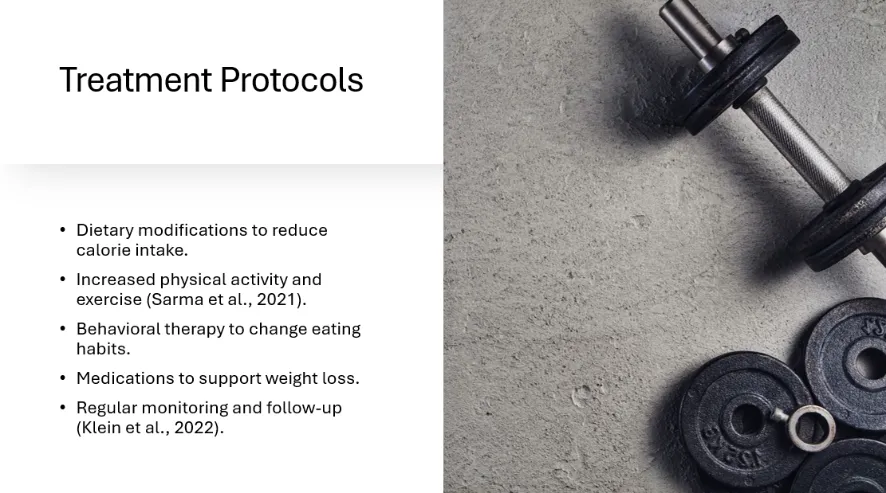
Slide 13: Pharmacology Treatments
Pharmacological treatments for obesity include appetite suppressants, metabolic enhancers, and lipase inhibitors. These medications support weight loss and are often used alongside lifestyle changes and behavioral therapy for better outcomes.
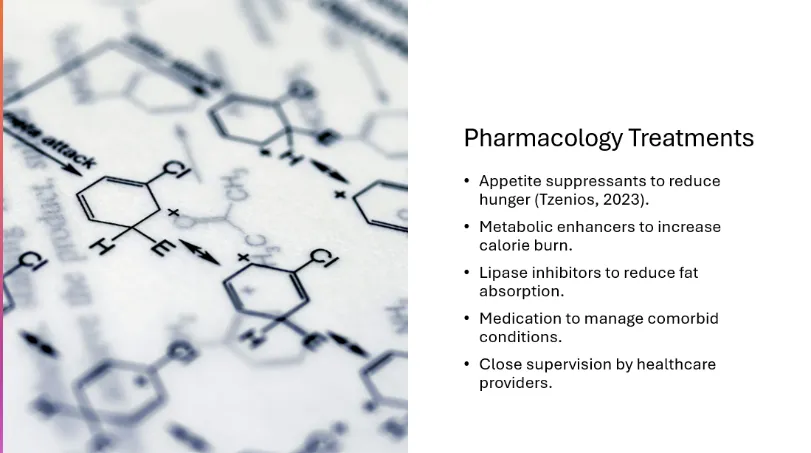
Slide 14: Support Systems
Support systems for managing obesity include counseling, support groups, family and community support, online resources, and professional guidance from dietitians and trainers. These systems provide motivation, encouragement, and essential resources for effective obesity management.

Slide 15: Prevention of Obesity
Preventing obesity involves encouraging healthy eating habits, promoting regular physical activity, raising awareness through public health campaigns, creating supportive environments, and conducting regular health check-ups. Prevention is critical to reducing the prevalence and impact of obesity.
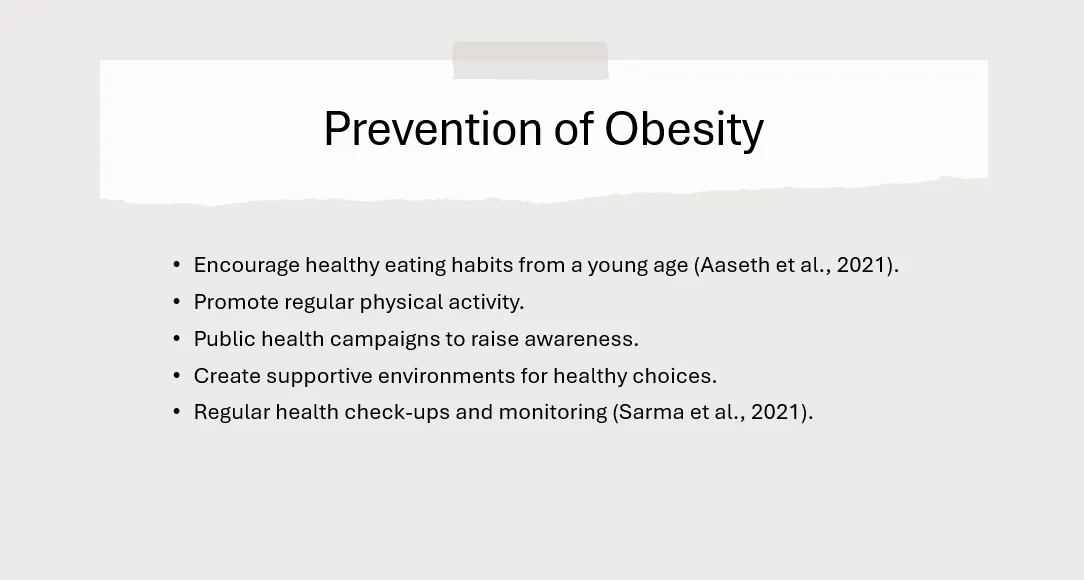
Slide 16: Health Information Management (HIM) Terms
Key HIM terms related to obesity include BMI (Body Mass Index), T2DM (Type 2 Diabetes Mellitus), WC (Waist Circumference), LBS (Laparoscopic Bariatric Surgery), and METs (Metabolic Equivalents). Understanding these terms helps in better communication and management of obesity.
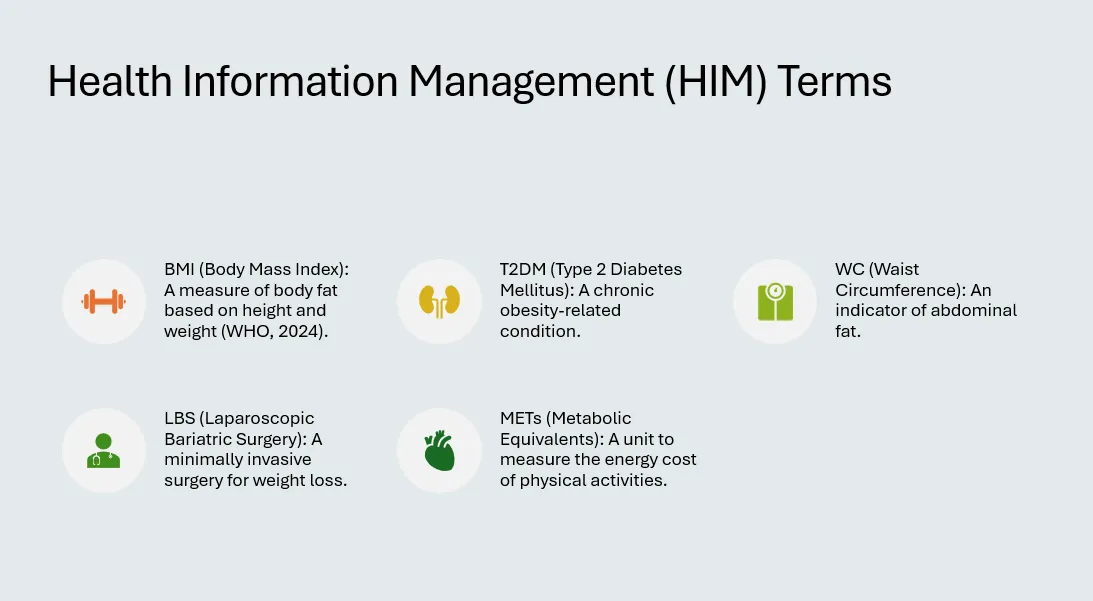
Slide 17: References
This slide lists all the references used in the presentation, formatted according to APA guidelines. It includes books, journal articles, and reputable websites. Accurate and organized references are essential for maintaining the credibility and integrity of the information presented.
